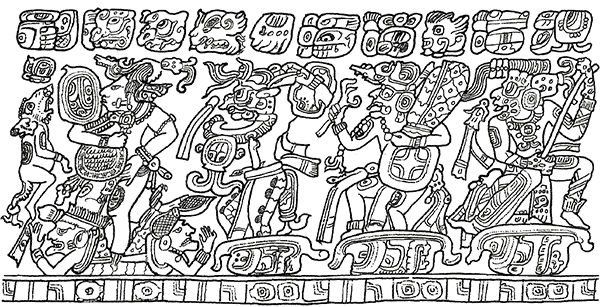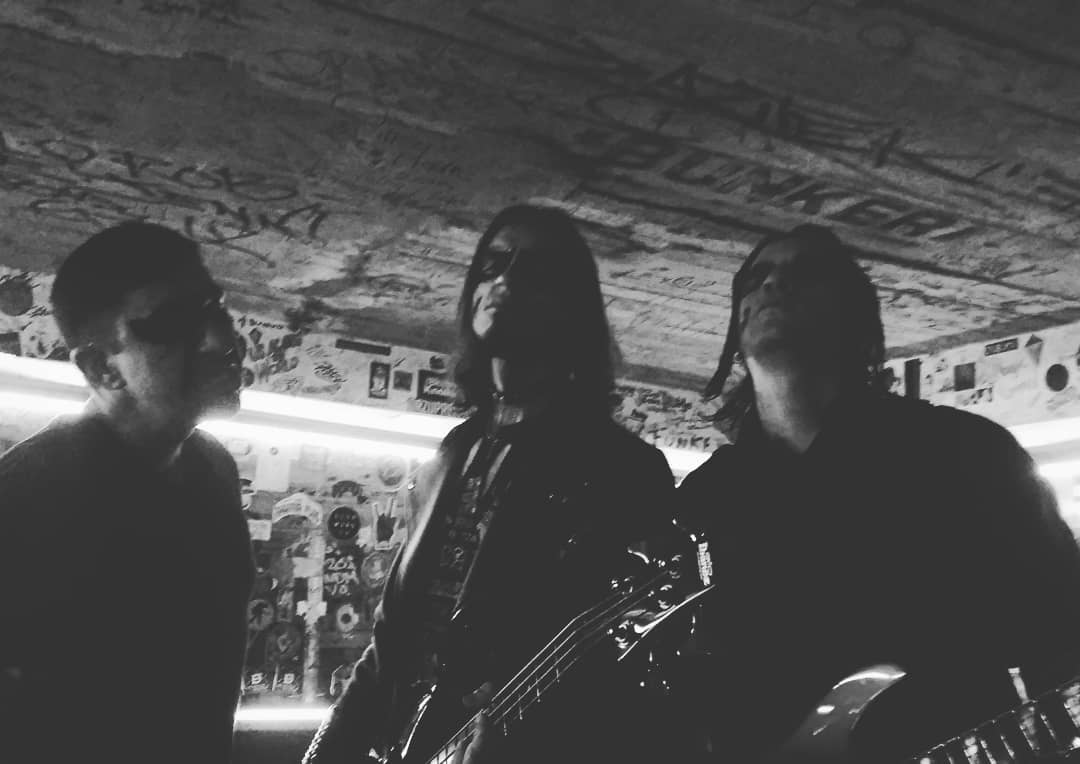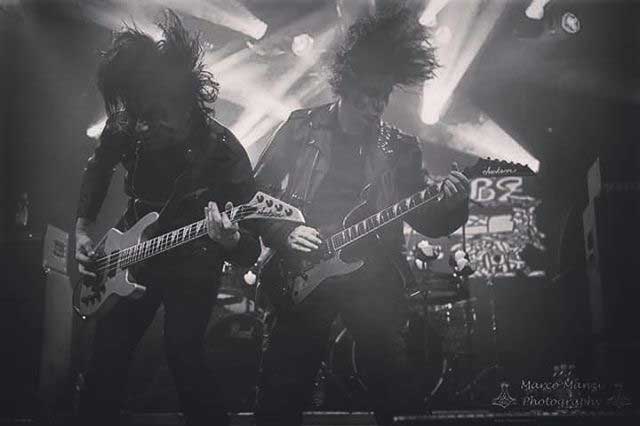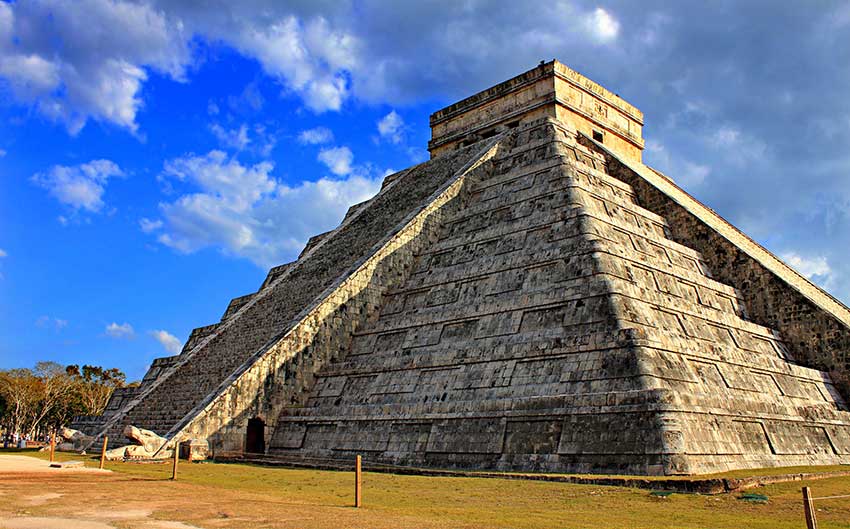Xibalba Itzaes
2018-09-19
by Niklas Göransson
Formed in 1992, Xibalba was one of Mexico’s very first black metal bands – guitarist and vocalist Marco Ek Balam discusses both early beginnings and Mayan stargates.
This article can also be found in Bardo Archivology Vol. 2, a printed anthology with selected features from the online archive. Additional content includes NÅSTROND, VOMITOR, NOCTURNUS, RYAN FÖRSTER, ANGELCORPSE, THE RUINS OF BEVERAST, ASCENSION, MALOKARPATAN, Manhunter: The Story of the Swedish Occultist and Serial Killer Thurneman, WARDRUNA, FORGOTTEN WOODS, LIFVSLEDA, SEIGNEUR VOLAND, and WOLCENSMEN – all presented in ambitious aesthetics with plenty of custom artwork. More information here.

– The new album, “Ah Tza Xibalba Itzaes”, was recorded with the help of a friend of ours. In total, it took us about four or five weekends to finish everything; all songs were already written and we knew the material well. The sound you hear is precisely what we wanted. The album retains the feel we’ve had ever since starting out – music and lyrics are equally important for the final result, so both our artistic influences and cultural roots can be found in every single song.
“Ah Tza Xibalba Itzaes”, the second album of XIBALBA ITZAES – originally known only as XIBALBA – was released by Nuclear War Now! Productions in October 2018. Their debut, the 1994 “Ah Dzam Poop Ek”, featured the same line-up: the very one they’d started out with two years earlier, only with the addition of Vic Ehxibchac on bass guitar.
– One reason could be that XIBALBA never did much touring, so we don’t see each other all the time. We share the same background and roots, I guess this contributed to things lasting until today. I should also point out that all three of us are brothers and go way back before the band even formed: to a period when we were discovering the good old rock and roll, hard rock, and heavy music from the late 70s and early 80s. An older brother of ours introduced us to the likes of KISS, LED ZEPPELIN, BLACK SABBATH, JUDAS PRIEST, and so on. Suddenly, we were drawn into a constant search for new bands and increasingly obscurer sounds. This was great, because it was a whole new world opening up to us and, besides, we were all young kids back then.
Marco says the Mexico City of the 80s offered very little in terms of a metal underground. The first acts playing fast and aggressive music were actually punk bands, influenced by the then-new English sounds of DISCHARGE, GBH, and THE EXPLOITED.
– A more evolved thrash scene emerged around ‘86 or ‘87. Before the explosion of thrash, black, and death metal, we had nothing besides a couple of bands trying to make heavy metal ala JUDAS PRIEST, SABBATH or DEF LEPPARD. We had very few places supporting metal bands and there was no proper promotion or management for anyone. Not many of the bigger foreign bands would play in Mexico, but those who did were highly praised; seeing them live was like a dream come true.
As the brothers grew into their teens, they became increasingly entrenched in the local scene. Building up a contact network of metalheads was essentially the only way for them to stay up to date with what was going on.
– Due to the fact that there was nothing else happening in our country, we embraced this tiny scene and made it our own. We evolved with the music as fans, witnessing first-hand how the hardest of heavy music went from SABBATH and PRIEST into unbelievable sounds such as VENOM, or the incredibly crushing guitars of METALLICA – no one had heard anything like it before. This was the first time I was totally blown away; it had a massive impact on me. The second time was with NAPALM DEATH’s “Scum”… that music could’ve gotten to such a point felt absolutely insane. I detected some influences in their music that led me to revisit old CELTIC FROST which, in turn, led me back to BATHORY. This was when we had the idea to form our own band.

When Marco and his brother Jorge Ah Ektenel founded XIBALBA, there were very few Mexican black metal bands around. As such, they were regarded as fringe oddities in an already outcast scene.
– Our visual presentation caught quite some attention, but it was only later they realised what we were all about. At that point, the scene was pretty much divided between death metal, punk, and hardcore music on one side and those who were still into classic heavy metal on the other. Since there was very little backing from labels and no big places to spread the word, bands struggled for survival in a scene where there was little to no support except from some fans and local independent people who tried to organise gigs and release records. XIBALBA didn’t really get much attention in the early beginning, only from old friends – our mephitic cult. I must say, we were far more involved in the underground before forming the band. I remember attending all the local shows, meeting with musicians and even visiting some of their rehearsal places, writing to bands for demos, shirts, etcetera… and, of course, constantly reading magazines and fanzines. I also wrote an article for a Greek ‘zine about underground metal in Mexico City, trying to somehow promote our local scene.
Marco says that following the formation of XIBALBA, they essentially isolated themselves from the local scene and would engage with it only in conjunction with the five or six shows they performed.
– I remember this one gig in Monterrey; SHUB NIGGURATH were supposed to headline, but, for some reason, they couldn’t make it. So, in the midst of promoter panic, we got the call to fill their place. The only problem was that we didn’t have enough time to stay at the venue and be the closing band – we had to be the opening-act in order to catch our flight back home to Mexico City. And since everybody was expecting SHUB NIGGURATH, no one had any idea what they were looking at. Most in attendance stood outside during the whole set, it was only later they realised who we were and invited us for another show. On another occasion, we were supposed to play here with BLASPHEMY! There was a big flyer announcing the show but, for reasons unknown, it never happened. I still have the flyer though.
What did you think of all the black metal related drama in Norway?
– All those rumours were unbelievable – the murders, the violence surrounding the shows, and the church burnings. Surely, their living conditions were totally different compared to what you’d find in countries like ours. Burning churches around here wouldn’t have been a very smart move, beside the fact that most of them aren’t even made of wood. These events were physical projections of what the older bands started in the early 80s; the Scandinavians just took it to another level. Right or wrong, it shaped what black metal has become today so you’re free to judge that for yourself. I liked the first bands to emerge from Norway, especially DARKTHRONE – we followed them back since they played death metal. Witnessing the changes and how everything turned black was great; the music was fresh and interesting again after being immersed in a kind of standard and generic death metal that often became boring. To me, back in the day, black metal was an injection of vitality into a music scene that was literally dead.
I’m curious how 90s black metal gigs were in Mexico City. As has been discussed in Bardo Methodology before, underground concerts in many European cities were often quite rowdy and featured intolerant policies towards suspected ‘posers’.
– Yes, I remember hearing rumours about that; stories about people trying to prevent bands from playing because they weren’t true black metal, and how violent the environment was. I didn’t really know how truthful any of that was either. I must say, in Mexico City things were very different. From what I can recall, punk gigs were nearer to that chaos environment because of the tough attitude of the people involved and the ideals behind them – though it was also fuelled by alcohol, drugs, and the usual troublemakers. I remember not being allowed to attend any of those clubs for that exact reason, combined with my young age.

Ever since the 1992 “In Lucescitae Tristis Hiei” demo, XIBALBA’s primary conceptual focus has been on Mayan cosmology. The Maya first appeared around 1800 BC and reached their peak around the 6th century, settling the entire Yucatán Peninsula as well as current-day Guatemala and Belize, along with parts of Mexico, Honduras, and El Salvador. Independent Maya society existed until 1697 when the Spanish conquered its final remaining sovereign city-state, Nojpetén. Millions of their descendants still reside around the Yucatán today. The Mayans are renowned for complex hieroglyphs, highly accurate calendars, and advanced mathematics – but perhaps even more so for their incredible feats in structure and art.
– As you may have noticed, our lyrics are always in reference to an ending of the Mayan calendar and, in extension, the entire world through deluge or earthly implosion. Viking-era BATHORY was a very important influence in the decision to embrace our heritage. All lyrics have been attempts to promote our archaic past; I consider them poems, in which we always try to touch the lines of the skies and get as close as possible to the hands of the gods. Together with the music, we’re attempting to raise some level of spirituality. The past is entwined with both present and future; it will be your own ancestral connections that set you free from the modern world. To accomplish this, the musical foundation we grew up with – all the hard rock, heavy metal, thrash, black, or whatever you wanna call it – has been merged together with our cultural background. These ancient roots have come to define who we are today.
Following 9th century events which are still unclear, the great stone cities of the southern lowlands – with long histories of powerful dynasties, monumental architecture, strong infrastructure, and sophisticated water control systems – were abandoned by the Maya, ultimately leading to full civilisational collapse in the region. Mayan culture survived the southern downfall and its power-centre shifted northwards. However, anthropological records show notable changes in architecture and artistry as well as far less use of hieroglyphs. During this process, the Mayan state of Chichén Itzá forged an empire which, at least temporarily, united the region. This is a period repeatedly referenced in the lyrics of “Ah Tza Xibalba Itzaes”. Today, Chichén Itzá is primarily known for archaeological marvels such as El Castillo: a spectacular temple pyramid dedicated to Kukulkan, the god who takes the shape of a feathered serpent. The pyramid also has plenty of embedded cosmological symbology. For example, each of its four sides have staircases of ninety-one steps; added together, with the temple platform included, it boasts the neat number of 365 steps in total. The northern balustrade, which contains the entrance to its inner sanctum, features several sculptures of plumed snakes. Come autumn and spring equinox, they are joined by additional serpentry by way of triangular shadows cast by the afternoon sun striking the northwest corner, creating a visual illusion of Kukulkan himself slithering down his pyramid.
– Oh yes, it is an incredible experience to witness; it has to do with the way it was built. I can only recommend people to visit Mexico without the blindfolds of the modern world and immerse themselves in the landscapes and spirituality of these lands.

While the pyramid’s exterior is impressive in its own right, it almost pales compared to what lies beneath. In 2015, researchers using a technique called electrical resistance survey discovered that the pyramid was built on an enormous sinkhole, a so-called cenote. In a land where droughts are frightfully common, the life-giving cenotes – natural pits formed by groundwater pouring out from the limestone bedrock – were considered sacred and often revered by way of sacrificial offerings. The watery abyss discovered under the pyramid is twenty-five by thirty-five metres (82 by 114ft) wide, located twenty metres below the pyramid and covered by an approximately five-metre thick limestone slab upon which the temple stands. Two years later, November 2017, archaeologists working with sophisticated radar equipment were able to determine that there is an as-of-yet unexplored tunnel leading from within the Tomb of the High Priest, a smaller pyramid on the site, to the sinkhole under El Castillo. Then, in January 2018, researchers from the Underwater Exploration Group of the Great Maya Aquifer Project announced their discovery that the cenote under the structure is part of what’s been shown to be the world’s largest underwater cave system, running to a length of 346 kilometres (215 miles). It was already known that the Temple of Kukulkan had been erected exactly in the middle of four other cenotes; to the north, south, east, and west. As such, it’s long been believed that it was meant to represent the axis mundi, or cosmic axis: the centre of the world where heaven and earth collide to lay bare passages into the underworld.
– These four squares were the main idea behind the creation of the cosmos and the place in which we all live, so no wonder the Mayans used it to build the structures and temples – and no wonder about the cenotes in Chichén Itzá either. Still, it’s both unbelievable and odd in some ways how they managed to build a temple above one of them. Our cosmic heritage is undeniable!
Do you think it would be best to leave such sites undisturbed, or should they be properly excavated?
– I think these places should be respected far beyond the idea of turning them into the next tourist attraction. Sadly, in the end, it’s all about money. There’s much wisdom entrenched in Mayan mythology and many profound places to visit. I guess everybody is welcome to dig into our past and learn a little about it; wisdom is vast and widely available for those with real interest.

This article can also be found in Bardo Archivology Vol. 2, a printed anthology with selected features from the online archive. Additional content includes NÅSTROND, VOMITOR, NOCTURNUS, RYAN FÖRSTER, ANGELCORPSE, THE RUINS OF BEVERAST, ASCENSION, MALOKARPATAN, Manhunter: The Story of the Swedish Occultist and Serial Killer Thurneman, WARDRUNA, FORGOTTEN WOODS, LIFVSLEDA, SEIGNEUR VOLAND, and WOLCENSMEN – all presented in ambitious aesthetics with plenty of custom artwork. More information here.



